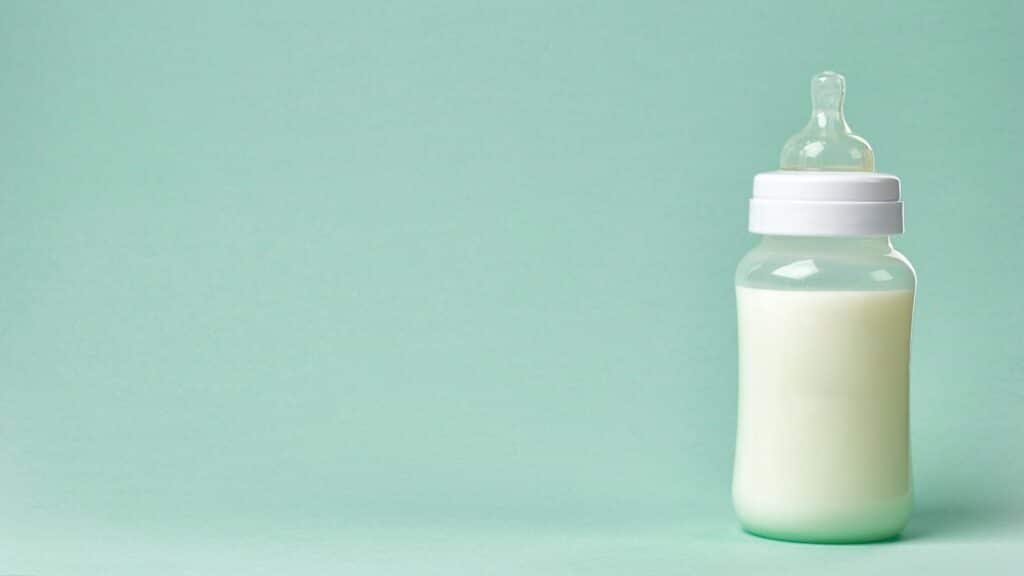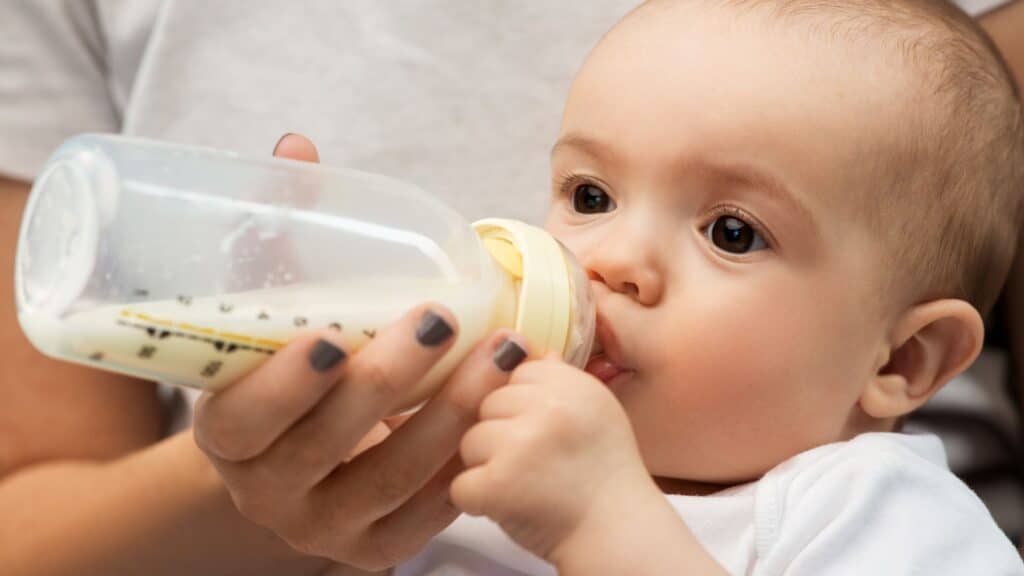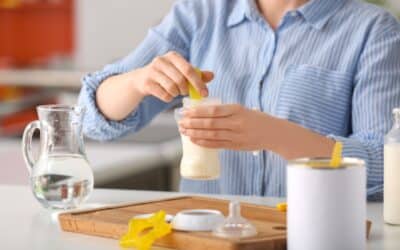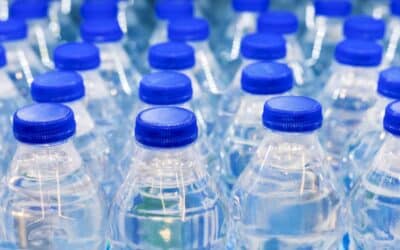Warming up formula milk for a baby can be a task that requires time and patience. Some parents may wonder if using a microwave to warm up the formula is safe. While the microwave may seem convenient, it is essential to understand the potential risks and safety guidelines to follow.
This content explores the topic of microwaving formula. It provides information on its safety and the proper steps to ensure correct warming. If you’re interested, continue reading!

Benefits of Warming Baby Formula
Babies may prefer warm formula when feeding, although no proven health advantages exist for heating formula milk. They often enjoy what they are accustomed to. Therefore, if you have consistently fed them with warm bottles, they might struggle more with consuming formula at cold or room temperature. Also, some babies who started with breast milk prefer their infant formula to be warm.
Another reason why most babies prefer a bottle of warm formula is that they use more energy to digest cold liquid than a warm formula. Since their body is still developing,
Fortunately, there’s a considerable chance that your baby may outgrow their preference through repeated exposure. Start by decreasing the times you give them heated formula until your baby adjusts to it. Although it may require some time, your baby will adapt to it as the weeks go by.
However, if you prefer to heat the baby’s milk before feeding, it’s best to be cautious to avoid overheating. If the formula gets too hot, it will cause the milk’s enzymes to break down, which can affect its nutritional value. Even worse is that it can cause scalding in the baby’s mouth, too [1].
Is it Safe to Warm a Baby Bottle in the Microwave?
The Food and Drug Administration (FDA) discourages everyone from heating breast milk or infant milk formula in the microwave. Studies show that microwaves primarily distribute the heat to the baby’s milk and formula bottle in uneven proportions. Thus, resulting in what people call “hot spots,” which can scald a baby’s mouth and throat.
Same with what happens when you microwave baby formula; baby food microwaved in a jar also gets heated unevenly. In most cases, you can even find the hottest spots in the center of the jar. Meanwhile, the coolest parts are next to the glass sides, which anyone could easily mistake for being entirely cold. So, to help you safely warm solid foods, here are a few things you need to remember:
Don’t Put Solid Foods Inside the Jar
When heating formula or solid foods inside the microwave, it’s highly advisable not to put them inside a jar. As previously discussed, when microwaves heat baby’s milk inside the bottle, the heat gets unevenly distributed. Thus, causing hot spots to develop, which may cause scalding in the baby’s mouth. So, to prevent it from happening, transferring the baby food to a dish is highly advisable before putting it in the microwave. Doing so makes it easier to stir the food to prevent the heat from accumulating at the center.
Only Microwave 4 Ounces of Solid Food
It’s best to only heat four ounces of solid food for at least 15 seconds on high heat. Also, stir the food and let it stand for half a minute. It’s also crucial to taste-test it before giving it to your baby.
Never Attempt to Heat Meat Sticks or Eggs in the Microwave
When heating baby-food meats, using the stovetops is an excellent choice. Remember that these foods contain high amounts of fat content, so heating them in the microwave only heats the fat faster compared to other parts of the foods. Thus, causing the melted fats to splatter and even cause overheating.

Is it Bad to Microwave Water for Formula?
Microwaving hot water in the microwave isn’t as bad as microwaving baby formula inside a water bottle. Most people even prefer boiling water in the microwave because it’s much faster than heating it on a stovetop.
However, it would be best to ensure that the water is at the right temperature before adding it to the bottle. Consider testing the temperature by putting a few drops of baby formula in your wrists and checking if the water bottles feel lukewarm.
Also, it’s important to note that you must only heat enough water for a single baby bottle. Never attempt to store leftover treated water in the fridge, or consider microwaving it again to prevent any potential contamination.
Finally, remember to be careful when handling heated water from the microwave. Remember that although microwaving water for baby bottles is easy, it can have an uneven heated temperature. So, it’s always best to ensure it’s at the right temperature before using it to make baby formula.
The Best Way Heat Breast Milk or Formula
When it comes to feeding your baby, it is vital to heat breast milk and formula safely and effectively. There are various methods for heating water for baby formula, but one way stands out as the best option: heating on the stovetop.
The stovetop method involves heating water by placing the bottle or container of milk or formula in the saucepan. The water should be heated until it simmers to eliminate the possible bacteria and other pathogens that may harm your baby’s health. However, it would be best to be mindful not to let it boil to prevent overheating the liquid.
Using the stovetop to prepare your child’s instant formula reduces the risk of overheating and damaging the nutrients in the milk or formula. Even more, using a heat-resistant glass bottle or container helps to prevent the buildup of harmful chemicals that can be released from plastic containers when exposed to heat.
Important Tips to Remember for Baby Formula Feeding
Now that you’ve decided to heat your baby’s bottle, it’s time to learn a few ways to prepare it, even without putting the infant formula in the microwave.
Read the Expiration Date
Check the label when you buy your baby’s formula to ensure it hasn’t expired. Milk or formula past its expiration date can cause serious harm to your baby, and expired liquid should never be used.
Wash Your Hands Thoroughly
Besides heating baby formula, one way to prevent contamination is by washing your hands with soap and water. It’s also best to dry your hands well after cleaning the area.
Sterilize the Bottle
It’s highly advisable to sterilize the bottles, caps, nipples, and rings before using them to make new baby bottle formulas. When sterilizing the bottles and the accessories, it’s best to put them in boiling water for five minutes. You can also use microwaved water steam sterilizer bag as an alternative option. Meanwhile, if you have a budget to spare, using a stand-alone electric steam sterilizer is another excellent option, especially if you’re hesitant to use a microwave after finding out that microwaves heat unevenly.
Add Sterilized Water
Lastly, ensure that you use sterilized water to mix your baby’s formula, especially when you’re using tap water. Although there’s no need to add water when using a ready-to-feed formula, you’ll need to add it to powder and concentrated liquid formulas to dilute the solution. If you’re unsure about the procedure, you can always read the instructions printed on the package.
Warm the Formula When Necessary
Although it’s okay to give your baby cold or room temperature formula, some babies do prefer warm water with their baby formula. So, if your baby prefers it that way, placing a bottle of baby bottled or food in a bowl of warm water is best. You can also run it under warm water to increase the temperature. Remember to test the bottles by putting drops on your wrists to check their temperature. It’s best not to warm water in a microwave, as the microwaves heat unevenly, creating hot spots which might burn your baby’s throat and mouth.

Conclusion
n conclusion, when it comes to heating baby formula, there are safer options besides the microwave oven. While the microwave is convenient and fast, it has some drawbacks that make it less than ideal for heating baby formula. Choosing the best method for you and your family is essential, considering factors such as convenience, safety, and preserving the formula’s nutrients.
Did this article help you? Comment down below if you have a question, we will get back to you as soon as possible!



